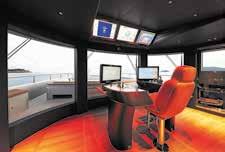
10 minute read
A bite-sized guide to the ‘perfect’ charter yacht
Guest Column
with Amanda Armstrong
Amanda Armstrong, founding partner at Yomira, draws on a combined 50 years’ experience to set out the essential elements that appeal to clients.
Guest Column
with Amanda Armstrong
Is there any such thing as the perfect charter yacht? Does it exist? Owners do not always build their yachts with charter appeal in mind, but the commercial aspect of chartering is very appealing – if only to offset some of the running costs of the yacht and keep the crew motivated when the family aren’t on board.
With a combined 50 years of experience of chartering vessels, the Yomira team has plenty of experience working with owners and captains across a broad spectrum of superyachts, both motor and sail. There are, of course, countless elements that go into making a ‘perfect’ charter yacht and we can break these down into digestible bite-sized important pieces.
All successful charter yachts certainly must have one key ingredient and that is a professional, proactive crew. Whether an owner is keen to manage certain aspects of chartering or leave it up to a company to handle all the details of the fiscal, operational and legal requirements, a very successful charter yacht is one that is properly looked after by a trusted captain and crew – from the mechanics, through to the cosmetic presentation and, ultimately, the front-of-house team who will interact with a variety of demanding guests.
Choosing the right representative to help position your yacht in the market is also both a personal and commercial decision. Does the size of the company really matter? Will you benefit from your yacht being serviced along with the rest of the fleet? How will the company market your yacht to stand out from the numerous other vessels they look after? Conversely, is a small, boutique, more focused and agile approach necessarily better? Will they have the appropriate reach in the market? Can they service your needs across the spectrum of requirements required for running a successful charter yacht, while also protecting your valuable asset and maximising your charter revenue? No matter how many offices the company has, will your representative have the necessary gravitas, experience and knowledge to market your yacht accordingly? The key is all about relationships and trust with your superyacht partner.
‘The Pressure of Leisure’ is an excellent fictitious name for a superyacht when considering the level of design that encompasses both the owner’s personal requirements, taste and own use of the yacht (perhaps as a semi-permanent residence or part-time office), as well as maximising the appeal for potential charter clients whose predominant reason for chartering is a holiday.
Motivations that drive client decisions can be very specific, but certainly understanding how your yacht might be used by other clients from an objective and practical point of view, compared to your own personal preferences, is essential. Can the beds convert to be either a double or twin? Will charter clients actually use a dining room positioned inside behind the galley? Would clients prefer more sunbathing areas rather than a Jacuzzi if there is also a swimming pool on board?
Of course, this is all rhetorical, but the reasoning behind all decisions is a very personal one. Having the right relationship with your superyacht representative is the answer; best practice for how and where you want your yacht to be represented. The photography needs to be excellent and ideally not the same as the majority of the yacht’s competitors; videos and 3D walkarounds are becoming ever more popular. Crew interaction, whether virtually or at boat shows, is important to ensuring clients have a human touchpoint for the yacht. And it goes without saying … toys, toys and more toys, the newer the better. Get two of everything. Clients rarely like to go Seabobbing on their own or take out the only kayak by themselves when all the other guests are enjoying cocktail hour.
The best charter yacht in our experience is one where the owner is happy with the yacht they have designed and has a contented, motivated crew, while also appreciating the requirements of charter clients. Rent yachts first. It may sound crazy, but are the crew personable? Are they able to switch from being very friendly with charter clients to being ultra-discreet, obviously on demand? Can they change from running an owner’s schedule to a charter itinerary? Is your chief steward(ess) able to be the main point of contact when the captain is potentially better employed driving the yacht?
It’s also worth bearing in mind that charter guests love continuity with crew; it’s ultimately the crew who make the charter. No other experience is as intimate as being on a yacht with the crew, so look at rotational positions. In our experience, crew who are on rotation tend to be happier as they have the opportunity to have some home life as well as being refreshed when they come back on board, and they also don’t look for work on other yachts quite so often.
In conclusion, the perfect charter yacht delivers an exceptional experience for the client, whether this is the owner or charterer. And this summation is completely personal. Luckily, no two yachts are the same or our job would be decidedly harder than it is already! AA
Futuristic bridge systems for the modern yacht
In the past year, Seastema has unveiled two highly innovative bridge systems for the yachting world. These sleek new designs illustrate the technological advancements found in navigation equipment, as well as the confluence of both style and function ...
The bridge on board a yacht has historically been the domain of the captain or senior crew, with many owners considering this part of a vessel a vital cog in the machine, but not somewhere to focus on aesthetically. However, the industry has started to incorporate sleeker systems into this area, as the technologies available can accommodate the complex needs of navigating a yacht into more stylish designs. One such company is Seastema, a supplier of integrated marine automation, navigation and communication technologies that works extensively with the Italian navy but also equips yachts with its bridge systems.
With more than 100 yachts utilising its equipment and thanks to a longstanding relationship with Benetti, in 2017 Seastema began discussions to develop two innovative new pieces of bridge equipment, the Light Bridge Console (on board the Diamond series) and Captain Chair (on board the Oasis series).
The Light Bridge Console provides users with an advanced system that dramatically reduces the cabling, electronics and controls of the bridge console, as well as a simplified user interface. The integrated system is controlled by two touch displays for safer and more efficient operation while minimising the amount of hardware needed. This equipment is also freestanding, which offers the crew unparalleled views of their surroundings.
“The console is so small and sleek, it completely transforms the design of the wheelhouse and facilitates control of the entire ship from the captain's position,” explains Antonio Spadoni, director of BU Systems and Foreign Markets for Seastema. “It looks so open and futuristic, owners are very happy to have it on board.” Throughout the design process, the Seastema team looked to Apple’s iPhone as inspiration for the system’s compact size and user-friendly interface.
On board Benetti’s Oasis models, the Seastema team developed the Light Bridge Captain Chair to be an even sleeker design, with the minimum of operator interface equipment resulting from the high level of integration required by flag states, installed in two touchscreen consoles either side of the captain’s armchair for completely uninterrupted views of the ocean. The equipment and computers are cleverly hidden away and the result is a highly minimalist design that could easily be at home in an ultra-modern sci-fi film. Captain Roberto Cuomo, of 40m M/Y Rebeca – the first of the Oasis models to have this system on board – reports that the owner and each of the yacht’s visitors “are impressed with the beautiful cleanness and futuristic design of the bridge” and that the new technologies allow the bridge to feel “like a living room overlooking the sea”.
The modern look of both the Light Bridge Console and the Captain Chair is also a result of its carbon-fibre construction. The material’s curved design is not only aesthetically pleasing but also dramatically reduces the weight of the equipment. “We are very happy with the result of using carbon fibre,” says Spadoni. “It’s very beautiful, lightweight, malleable resistant and technologically advanced.”
Seastema believes that these innovative concepts for the bridge not only elevate the captain’s experience navigating the vessel but also add an additional special space for guests to enjoy on board. By moving away from just functional design and clunky pieces of equipment, the modern, stylish bridge system can seamlessly blend with the rest of the yacht’s aesthetic while delivering all the functions necessary for day-to-day operations.
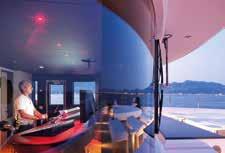
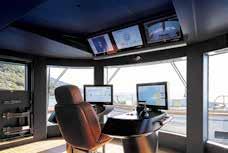

FUEL CELL TECHNOLOGY
by Philippe Himmelein, Head of Project Design and Naval Architecture Yachts
When considering the shift to green energy, it is vital to get the maximum energy from these systems as effi ciently as possible. The hydrogen fuel cell has a long history of providing an effi cient, sustainable solution across many varied applications. As well as the environmental considerations, an additional benefi t of a fuel cell is that it is practically silent compared to a diesel engine, and the owner experience is greatly improved.
At Lürssen, we have been carefully examining and researching hydrogen fuel cells, along with our partners, since 2009. Cooperation, collaboration and integration are a vital part of the Lürssen brand, and our fuel cell development exemplifi es this. We have committed to a strategic partnership with Freudenberg, one of the leading experts for maritime fuel cells. We both aim to bring fuel cells onboard ships in the near future and revolutionize the yacht’s energy and propulsion system. We have built a state of the art innovation laboratory on site, and the fi rst fuel cell will arrive this summer. Under real-life ambient conditions and with all required auxiliary systems, this demonstration plant will be the fi nal preparation necessary to bring fuel cells onboard a yacht successfully.
The challenge for a cleaner and more sustainable fuel system is that it needs to deliver on these promises without compromising the design and operational profi le of a highly performing superyacht. Lürssen’s and Freudenberg’s concept is a fuel cell driven by hydrogen which is reformed from methanol on request.The choice of methanol rather than elemental hydrogen has been made due to its higher energy density, the simplicity of handling and easy world wide availability. The lighter energy density of methanol compared to diesel requires increased tank storage volume. Still, crucially, there is signifi cantly less impact on the guest spaces, such as would be seen due to the installation of explosion proof areas and complex ventilation systems that gases such as elemental hydrogen and LNG require.
A greener energy source must be judged across the entire process, and methanol presents a solution that is already a biproduct of many other chemical reactions. Additionally, it can be produced using green energy such as solar. At Lürssen, these technologies are a part of every new build discussion. We have pioneered the use of diesel-electric prolusion on our projects in the past. These early hybrid systems provide a model of innovation that we can follow to drive our next step, creating a new generation of Lürssen superyachts with sustainable propulsion solutions.
At Lürssen, we now have a pioneering, technology driven client for whom we are incorporating this history of technological development and research into a groundbreaking new-build superyacht. This revolutionary methanol-hydrogen powered vessel will be able to cruise at slow speeds for 1000 miles or spend 15 nights at anchor emission-free and silent. Customer and industry expectations for a sustainable yacht are growing; we will do everything we can to continue to lead the way ahead and make the dream of an emission-free yacht a reality.
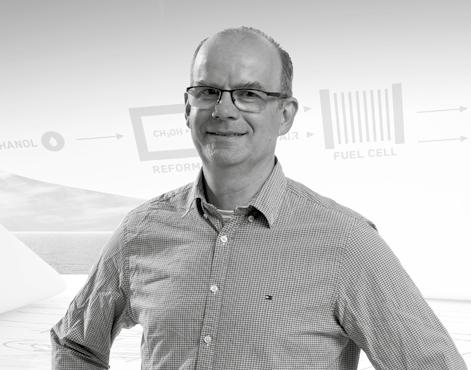
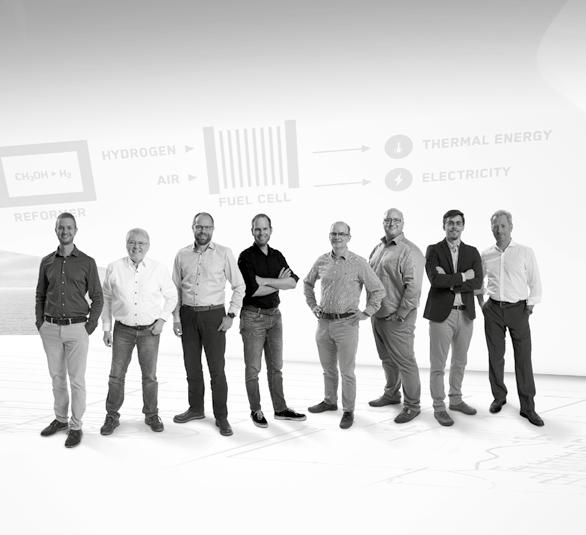
THE LÜRSSEN THINK TANK
We all see that the world of energy is changing, and the ethics of the traditional methods of energy production are being debated across all industries. The superyacht industry is a vital part of the evolution of this debate. At Lürssen, we believe that we have, as an industry, a chance to strive ahead. With the freedom in design from visionary owners, and the willingness to innovate, we can integrate ground-breaking technologies.











